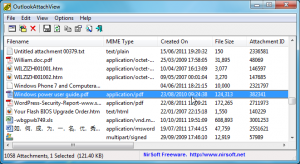 Use Outlook for a while and it’s all too easy to build up a bulky Inbox, weighed down in particular by all the attachments you’ve received. And while you can delete or save these individually, Outlook doesn’t provide any global way to manage all your email attachments. Which is why you may well need NirSoft’s OutlookAttachView.
Use Outlook for a while and it’s all too easy to build up a bulky Inbox, weighed down in particular by all the attachments you’ve received. And while you can delete or save these individually, Outlook doesn’t provide any global way to manage all your email attachments. Which is why you may well need NirSoft’s OutlookAttachView.
The program has more filtering capabilities than we expected. So, for instance, you can choose to view only attachments sent within a particular date range, of a particular size or file type, from a specified group of senders, or to defined email addresses, amongst other options. But if you don’t care about any of that – or you’re just in a hurry -- simply click OK on the opening Scan Options dialog and OutlookAttachView will show you all the attachments for messages stored in the default Outlook profile.
The attachment report is also surprisingly detailed. So you’ll see the attachment file name; the email address and computer it came from, as well as the email client used to send it; the date it was sent; the subject, MIME type, and of course the attachment file size.
If you’re looking for quick cleanup, then clicking the File Size column header will sort the attachments by size. Select any of the top few files that you’re sure you won’t need, click the Delete button, and that’s it: they’re gone. (The original email message remains, though, if you look -- it just won’t have an attachment any more.)
Or alternatively, if you select particular files of interest (or press Ctrl+A to select them all), then use the right-click “Copy” option, OutlookAttachView will save your chosen attachments to a folder, so now you can view or manage them without having to go through Outlook each time.
You do have to be cautious how you use the program. Think carefully before you delete something, for instance -- there’s no way to recover an attachment you’ve wiped accidentally. And in particular be wary of opening attachments you don’t recognize. OutlookAttachView doesn’t have any security warnings before launching attachments which may contain executable code, so if that mystery XLS or PDF file contains malware then opening it may infect your PC.
These issues aside, though, OutlookAttachView is a very useful way to examine and manage your Outlook attachments. It’s powerful and packed with features, yet like most NirSoft programs, remains tiny -- only 123KB, including a Help file.
Please note, OutlookAttachView comes in two builds. Use the 64-bit edition for 64-bit Outlook 2010, while the 32-bit edition should work well for everything else (Outlook 2003, 2007 or 2010).

